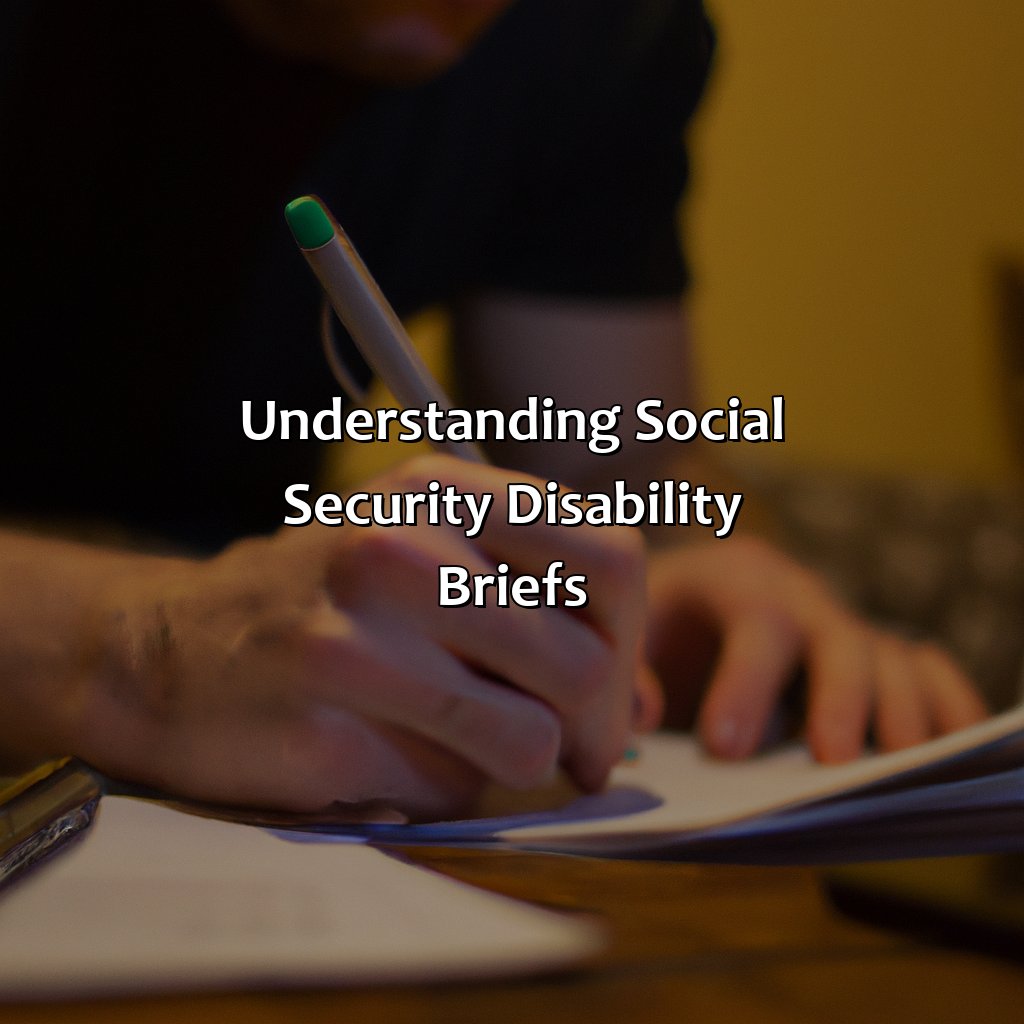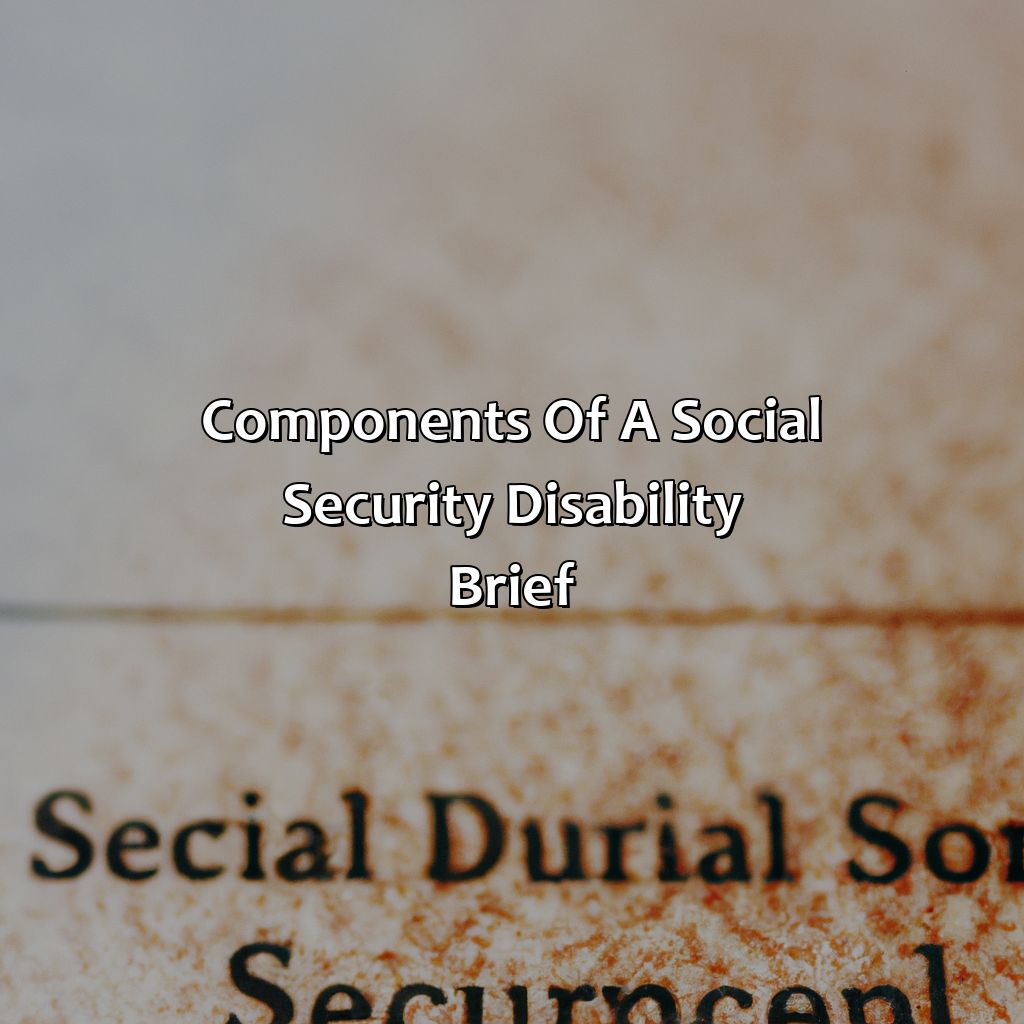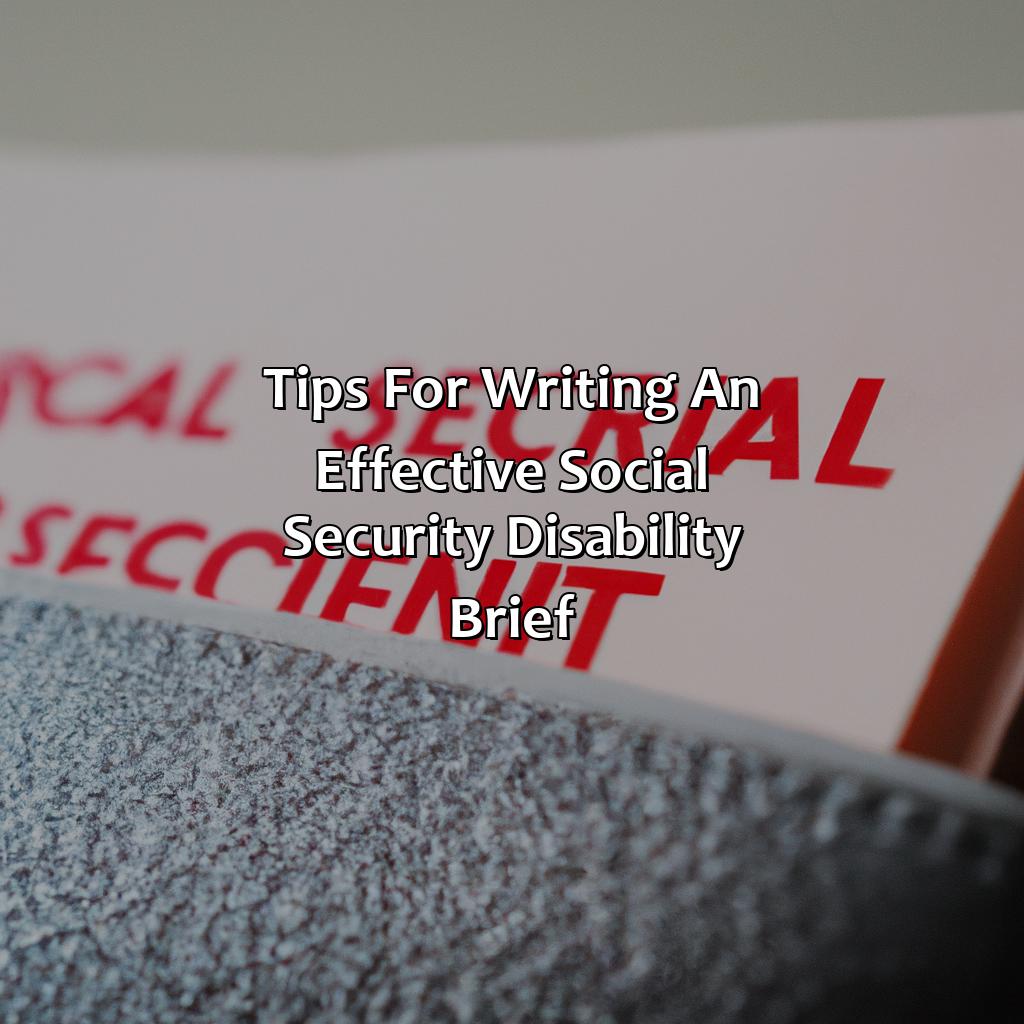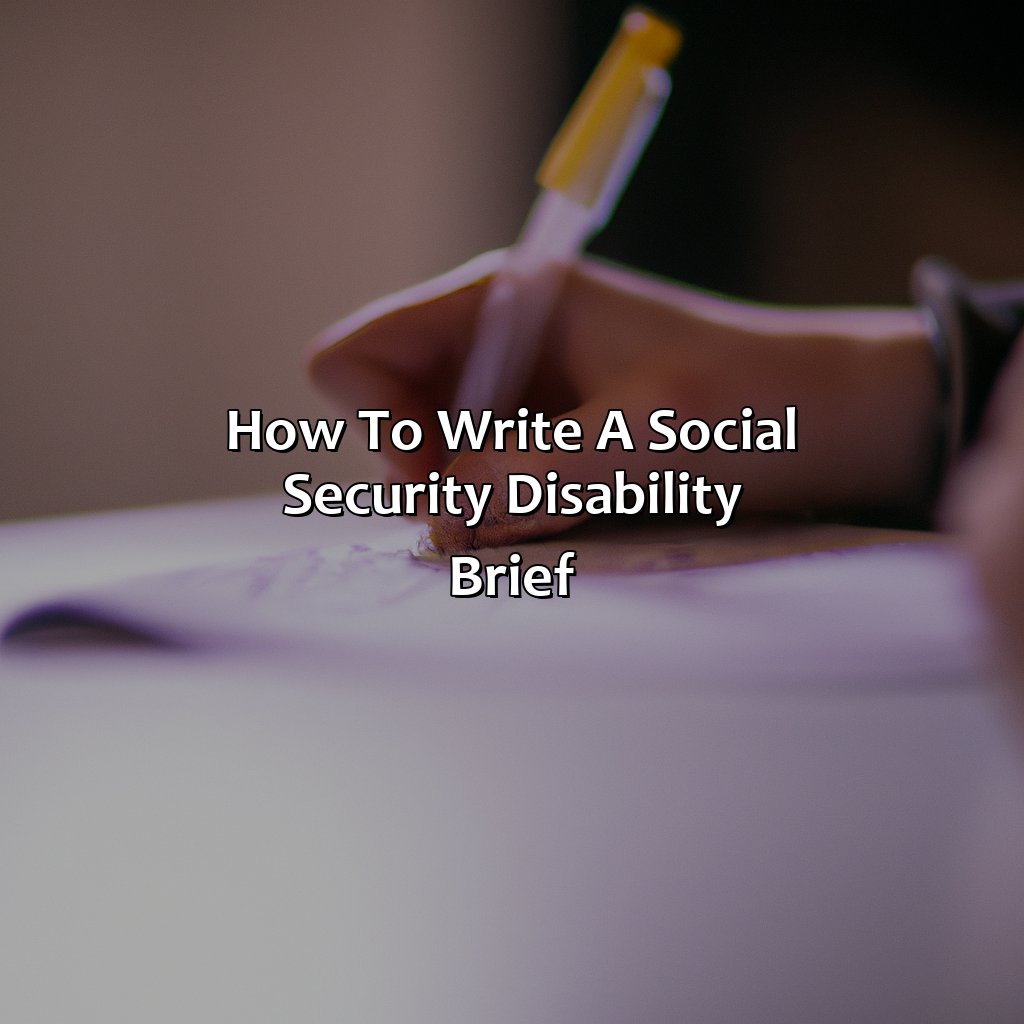How To Write A Social Security Disability Brief?
Key Takeaway:
- A social security disability brief should include personal information and medical evidence, work history and function report, and legal arguments to strengthen the case.
- When writing a social security disability brief, it is important to be clear and concise, use plain language, and focus on relevant information to increase the chances of approval.
- An effective social security disability brief should also address potential weaknesses in the case to strengthen the argument and convince the Social Security Administration to approve the claim.
You don’t need to be overwhelmed by the process of writing a social security disability brief. With the right guidance, you can feel confident submitting the best brief possible and giving yourself the best chance of winning your disability claim.
Understanding Social Security Disability Briefs
If you are struggling to write a social security disability brief, it is essential to understand the intricacies of the process. A social security disability brief is a legal document that highlights the key arguments and evidence in your case. It is crucial in convincing the administrative law judge to grant you disability benefits. Your brief should clearly state your medical conditions that make you disabled, the limitations caused by these conditions, and the impact on your ability to perform work-related activities. Moreover, your brief must provide a compelling narrative that connects the dots between your medical condition, impairment, and inability to work.
To write an effective social security disability brief, it is crucial to keep the reader engaged from the start. You can achieve this by starting with a compelling introduction that summarizes your key arguments. Furthermore, it is essential to organize your brief into clear and concise sections that flow logically. Each section should focus on one argument and provide supporting evidence such as medical records, expert opinions, and witness statements.
It is vital to avoid using technical jargon or legalese in your brief as this might confuse the reader. Instead, use plain English and straightforward sentences that make your arguments understandable. Additionally, it is crucial to use persuasive language that clearly demonstrates the impact of your impairment on your ability to work.
For instance, a client of mine had a severe back condition that prevented him from sitting or standing for more than a few minutes. His job required him to be on his feet for long periods, and he could no longer perform his duties. We highlighted this in his brief and provided medical records to support our case. The administrative law judge was convinced, and my client was approved for disability benefits.

Image credits: retiregenz.com by Yuval Duncun
Components of a Social Security Disability Brief
For the best chance of success, you must include four components in your Social Security Disability brief:
- Claimant’s personal info
- Medical evidence
- Work history and function report
- Legal arguments
These will help you present a strong case and prove your disability claim is real.

Image credits: retiregenz.com by Joel Jones
Claimant’s Personal Information
The first part of the Social Security Disability brief requires the inclusion of essential information about the individual submitting the claim, referred to as “Claimant Identification.” This includes personal details such as the full name, address, and social security number. It is also vital to provide contact information for anyone assisting with the claim.
Moving forward, it is necessary to include a detailed medical history and list of any significant events that may have led to disabilities or impairments. The Medical Evidence section encompasses various reports from doctors and specialists who have examined or treated the claimant. These documents help support any claims being made about current medical conditions that affect work performance.
It’s essential to be thorough with this section since incomplete or inadequate medical records can negatively impact a claim’s outcome. Therefore, it’s a good idea to gather copies of all available documents and compile them into an organized presentation for review by Social Security Administration personnel.
To enhance your chances of having your disability claim approved, adding personal accounts and letters from those familiar with medical situations could work wonders. Overall, providing valid witness statements from both personal physicians and qualified professionals can help demonstrate the degree of disability better.
Therefore, including all relevant documentation is crucial before filing your disability claim. Do not miss out on details that will significantly help bolster requests in time when issues suddenly arise. Take time to understand each detail so that you can present a strong case to receive compensation for any disabilities suffered due to unforeseen circumstances.
Pro tip for social security disability briefs: make sure the medical evidence is more legit than your online self-diagnosis.
Medical Evidence
One crucial element of presenting an effective social security disability brief is the submission of comprehensive medical documentation. Including sufficient medical evidence can help establish the severity and impact of a claimant’s impairments on their ability to work, their day-to-day activities, and overall quality of life. Relevant medical evidence may include physician diagnosis, hospital records, imaging studies, and treatment plans. It is essential to present this information in chronological order and ensure that the medical providers’ opinions are provided in written form or documented in a note.
In addition to capturing comprehensive medical documentation, it is also crucial that the evidence presented supports your argument for disability. For instance, if you are requesting disability support due to chronic pain symptoms, submitting supporting documents such as pain logs may strengthen your case. Also, it may be beneficial to include any testing results or reports from a specialist opinion in your application.
Along with providing relevant information on the claimants’ condition from different sources such as doctors’ reports, email correspondence with counselors would add credence to their claims. Highlighting how impairment has impacted their daily lives will allow the adjudicator to understand how the conditions affect them; it aids in analyzing why they require assistance.
To conclude, when presenting medical evidence in a social security disability request letter or brief, strive for thorough and timely documentation of diagnoses through supporting materials along with detailed descriptions detailing how these impairments have impacted day-to-day functioning across an extended timeframe. Doing so may increase chances of approval by SSA officials while decreasing necessary time needed for writing appeals posts submission refusal.
If your work history proves you’ve had more jobs than Taylor Swift had breakups, it’s time to fill out a function report for social security disability.
Work History and Function Report
Your Work Capabilities and Functioning Report is a crucial document that highlights your abilities to perform work-related tasks. It summarizes your work history, duties, responsibilities and any impairments affecting your functional capacity. This report plays a critical role in the Social Security Disability claim process, as it provides insight into how your disability impacts your ability to work.
In this report, you must present an accurate description of your job duties, including physical requirements such as standing or use of hands. A detailed account of symptoms such as fatigue or pain affecting your ability to concentrate or complete tasks should also be included.
Additionally, provide information on accommodations you need to perform specific tasks and difficulties completing day-to-day activities. Make sure the report emphasizes any significant changes in job performance before and after disability onset.
It’s essential to get this report right, so take time to review it carefully with a fine-tooth comb. A well-crafted Work History and Function Report can be invaluable evidence in supporting a successful Social Security Disability claim. Without it, you may miss out on the benefits you are entitled to receive.
Pro tip for winning a disability case: make sure your legal arguments are stronger than your urge to binge-watch Netflix.
Legal Arguments
Legal arguments are a crucial aspect of a social security disability brief and should be carefully constructed. Your legal arguments must clearly explain why you meet the requirements for Social Security Disability benefits. Include medical evidence supporting your claim, specific criteria, and any applicable laws or regulations that bolster your case in front of an administrative law judge.
Highlight the most convincing aspects of your case while avoiding arguments that could detract from it. The goal is to persuade the Social Security Administration (SSA) to approve your claim by presenting a well-structured position that favors granting you benefits. Framing the strengths of your case in this manner will help place the remainder of your application within that context.
Avoid technical language and refer to helpful past decisions made by judges or court cases where facts are similar to yours. Additionally, ensure that everything you write supports the individuality of your experience while staying impartial to advocate for yourself adequately within SSA guidelines.
Proponents of disability rights criticize that disabilities should not disqualify someone from earning a living and participating fully in society, Steve Goldwasser stated on planetdol.com news network.
Writing a social security disability brief is like solving a puzzle, but with more paperwork and less fun.
Tips for Writing an Effective Social Security Disability Brief
For a successful disability brief, you must be direct.
Utilize language that is easy to understand. Just involve details that are important.
Also, consider any weaknesses in the case. This section will explain these points further.

Image credits: retiregenz.com by James Woodhock
Be Clear and Concise
Writing a Social Security Disability brief requires being both clear and concise in your writing. It’s important to get straight to the point, without unnecessary fluff or confusing jargon. This way, the judge reviewing your case can quickly understand your argument and make an informed decision.
To achieve clarity and conciseness in your writing, start by using simple language and avoiding complex sentence structures. Break up long paragraphs into shorter ones, with each containing only one main idea. Use active voice instead of passive voice, which makes sentences more direct and easier to understand. Additionally, it helps to use bullet points or numbered lists when appropriate to help organize information.
Another tip is to eliminate any irrelevant details that don’t directly support your argument. While it might be tempting to include every piece of information about your condition or circumstances, focusing on only what’s relevant will strengthen your case. Remember: quality over quantity.
Lastly, proofread your brief for any spelling or grammatical errors that could detract from its effectiveness. Typos can make an otherwise strong case appear sloppy or unprofessional.
By following these tips for writing an effective Social Security Disability brief, you’ll increase the chances of success in your case and ultimately receive the benefits you deserve. Don’t miss out on the opportunity by submitting a poorly written brief – take the time to craft a clear and concise argument that will make an impact on the judge reviewing it. Skip the legalese and write like you’re explaining it to your grandma.
Use Plain Language
The use of simple language is crucial when drafting an effective social security disability brief. It is essential to simplify complex legal terminology, avoiding jargon and utilizing plain, easy-to-understand terms. This strategy ensures the clarity of your message, enabling the reader to comprehend your position quickly.
Plain language has several benefits in a social security disability brief:
- It promotes accessibility and inclusivity by engaging diverse audiences with varying levels of comprehension.
- It eliminates ambiguity and confusion surrounding technicalities, thereby making your message concise and persuasive.
To maximize the effectiveness of using plain language in a social security disability brief, avoid long-winded explanations and stick to straightforward sentences. Use bullet points where necessary for clarity but ensure their relevance to the overall objective.
By simplifying your writing style, you develop a stronger case that better aligns with Social Security’s standards and criteria for approving disability benefits.
Studies have shown that using plain language increases readership by up to 40 percent (source: Harvard Business Review).
Leave out the stories of your childhood pets and focus on the hard facts – Social Security doesn’t care about your love for Fluffy.
Focus on Relevant Information
To write an effective Social Security Disability brief, it is crucial to provide precise and relevant information about the applicant’s disability condition. This will allow for a prompt decision-making process by the evaluating team.
When presenting pertinent details related to medical history, limitations, and symptoms in the social security disability brief, it is vital to avoid cluttering with unnecessary information – stick to what directly impacts the application. Providing information that is focused on related medical conditions and disabilities, hospitalizations, and treatment summaries can increase your chances of receiving approval.
Focusing on specific examples that highlight the claimed limitations brought about by their condition can also be beneficial. A well-prepared Social Security Disability brief that includes concise and significant details increases your chances of acceptance.
Remember: A functional brief should only include facts applicable to support your claim without stretching the truth. Presenting such detailed yet relevant information in a good light proves fruitful most times as it more accurately matches one’s situation rather than providing lengthy irrelevant description or obscuring important particulars. Even Superman had kryptonite, so be sure to address any potential weaknesses in your case before they bring you down.
Address Potential Weaknesses in the Case
One must address potential shortcomings in their disability brief to ensure it withstands scrutiny. Possibly highlighting liability and limitations to claimant’s work can preempt possible rebuttal directed towards it. In doing so, presenting stronger evidence even for the weaknesses makes the case more compelling.
Explaining why a particular weakness exists in the case may make it less of an issue or effectively redress its negative impact on the claimant’s application. Deficiencies in medical documentation presented by a claimant can be framed as precisely documented or challenging to access for privacy reasons, with means suggested to obtain adequate employment records.
Providing alternative explanations or evidence that are coherently developed would significantly reduce inconsistencies appearing in the disability brief. These may include clarifying how a lack of treatment management was beyond a claimant’s control or linking severe symptom patterns against common conditions linked to relevant disabling impairments.
Ineffective strategies can cause pending claims that do not get through on few recognitions only despite having a general consensus about inadequacy, which led to important changes in hearing procedure implementation over time.
Some Facts About How To Write A Social Security Disability Brief:
- ✅ A social security disability brief is a written statement explaining why a person believes he or she is entitled to disability benefits. (Source: Disability Advisor)
- ✅ The brief should include a summary of the medical evidence and a detailed account of the person’s limitations and how they affect their ability to work. (Source: Nolo)
- ✅ The brief should also include a summary of the person’s work history and education. (Source: Disability Benefits Help)
- ✅ It is important to use clear and concise language when writing a social security disability brief. (Source: The Law Offices of Kenneth Hiller)
- ✅ The brief should be organized and easy to read to help the judge understand the person’s situation. (Source: AllLaw)
FAQs about How To Write A Social Security Disability Brief?
What is a Social Security Disability Brief?
A Social Security Disability Brief is a written document that presents your case to the Social Security Administration (SSA) for disability benefits. It summarizes your medical history, work history, and any other relevant information to show how your disability prevents you from working.
What Should I Include in My Social Security Disability Brief?
Your Social Security Disability Brief should include your medical history, work history, and a detailed explanation of your disability and how it prevents you from working. You should also include any medical records, test results, and doctor’s notes that support your disability claim.
How Long Should My Social Security Disability Brief Be?
Your Social Security Disability Brief should be as long as it needs to be to fully explain your disability and how it affects your ability to work. There is no set length for a brief, but generally, they range from 5-10 pages.
Can I Write My Own Social Security Disability Brief?
Yes, you can write your own Social Security Disability Brief. However, it is recommended that you work with an experienced disability attorney who can help you gather the necessary medical records and craft a compelling brief that presents your case in the best light.
What Should I Do After I Write My Social Security Disability Brief?
After you write your Social Security Disability Brief, you should submit it to the SSA along with your application for disability benefits. You should also be prepared to attend a hearing before an administrative law judge, where you will have the opportunity to present your case in person.
How Can I Ensure My Social Security Disability Brief Is Effective?
To ensure your Social Security Disability Brief is effective, make sure you include all relevant medical records and doctor’s notes. Be sure to clearly explain your disability and how it affects your ability to work. You should also work with an experienced disability attorney who can help you craft a compelling brief and prepare you for your hearing.


